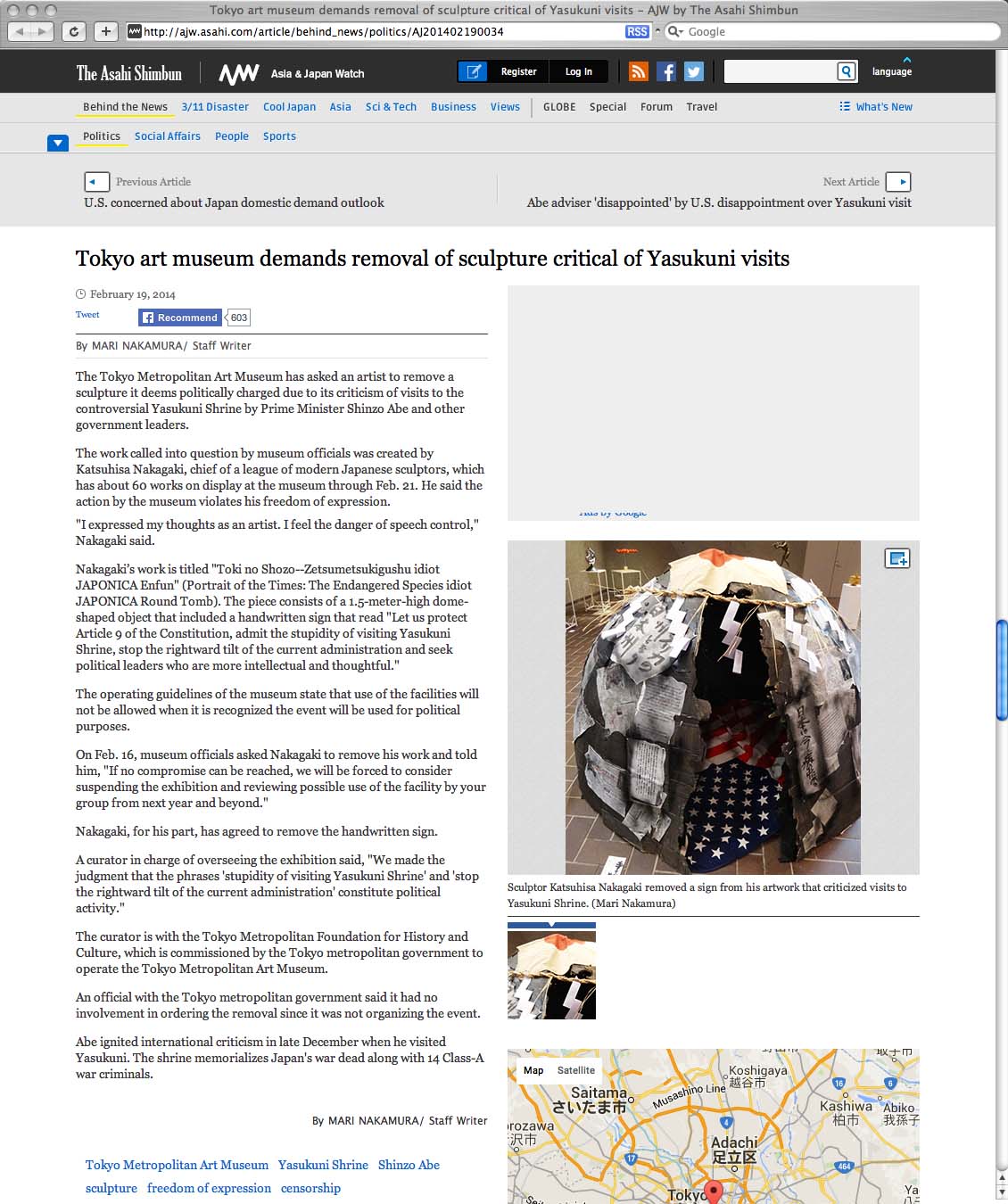Asahi shinbun (online) 19.2.2014 / Mari Nakamura
http://ajw.asahi.com/article/behind_news/politics/AJ201402190034
|
|
_a.jpg) |
(translation of the above)
Kanagawa Shinbun 6.8.2014 / Hiroyuki Nakano
The pressure that built up before and during the War.
Box top left:
In the revision of the "Law for the Protection of Secrecy" and in security policy under Prime Minister Abe, Nakagaki saw the degeneration of Japan into a "country at war". With his work, which is modelled on the form of a Kofun, a Japanese burial monument type from the 3rd Century, the artist intended to portray "the end of Japans peace".
Box top right:
Chiselling time in stone
In February, Katsuhisa Nakagaki (70), an artist from the city of Ebina, was compelled to remove a work entitled "Portrait of our Era" from the exhibition space in the Tokyo Metropolitan Art Museum. The work included a text in which the artist criticized Prime Minister Abe Shinzo for visiting the Yasukuni Shrine, where, among other things, the war crimes of the Second World War are commemorated. "We are not concerned for our rights of freedom of expression and freedom of opinion, but only demand that deviant opinions should be eradicated from society."
For the artist, who was born at the end of the Second World War and whose father served in the State Police Force, coming to terms with the past is a major concern.
Small box, centre:
The press reported the incident in a flash. On the internet, the museums reaction received a good deal of support and not infrequently Nakagakis chosen form of expression was criticized.
Box below:
Why is it that only soldiers are considered to be heroic souls?
Nakagakis art has always been concerned with war and peace. This is connected above all with his childhood, which he spent in the town of Hida in the Gifu Prefecture. He himself was born in 1944 and so had no memories of the War, but he grew up with his parents stories of the devastation on the home front.
His father Masao had been a member of the State Police Force on duty in a mine where he was responsible for overseeing a group of Koreans doing forced labour there. "He had his doubts about the groundless acts of violence towards the Koreans and told me about them precisely for that reason without glossing over the facts." His mother Hisako was unable to forget what she had seen when fleeing from an air raid with her two children and boarding a train: ĺ─˙Before the very eyes of starving children, two soldiers were wolfing their meal. What is this war for - and for whom? On many occasions I expressed my anger about the senselessness of the War."
After the War, Masao was imprisoned as a Class C war criminal, and the family fell into poverty. There were also many whose relatives had been killed in the air raids or on the battlefield. Nakagaki summarizes his intention when making the work "Portrait of our Era" in the following words: "It is not only the atrocities committed during the War by other countries that politicians seem to have failed to come to terms with and to prosecute, but also those committed by our own country. My work includes and incorporates this fading sense of crisis." A consequence was his criticism of the visit to the Yasukuni Shrine commemorating the war dead and the military officials. "Those who lost their lives in air raids, the unnamned citizens, the bodies charred by the atomic bombs dropped on Hiroshima and Nagasaki, all those who suffered from the War - they are all part of our nation. How can it be that only the souls of soldiers and military officials are seen as something special? "Portrait of our Era" is the expression of my indictment."
An Unbending Will
31 May. In a gallery in the town of Tachikawa, Nakagaki unveiled a new "Portrait of the Era". As expected, the work had the same dome-shaped form. The outside is now painted white and the paper with the disputed text is on the interior. The new inscription reads: "We believe that we should protect ourselves from invasion by other countries by means of re-armament, yet by this trial of strength we buy nothing but suppression and rancour." In the ensuing debate, there was direct criticism of the readiness to make use of the collective right to self-defence. Nakagaki wanted not only to make his comment on the silences of the Yasukuni debate, but also to create something that went much more deeply into the issue.
"Even if this is a past about which there is much to be said, it cannot be forgotten that the Second World War was a war of aggression and that the Yasukuni Shrine glorifies this history." The pure, white appearance from outside symbolizes the fact that the corresponding banner was again removed; at the same time, however, the banner hidden inside is evidence of an unbending will. For the artist, creating this work was a sublimating act of rebellion. "It is terrible that there is such a power that leaves us incapable of speaking and that robs our words of all meaning should we nevertheless do so. It is the same situation as before and during the War." |
|
|
|
|